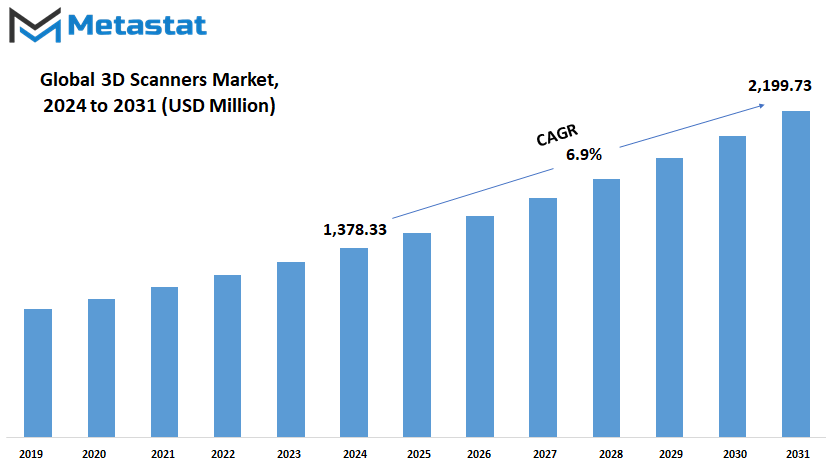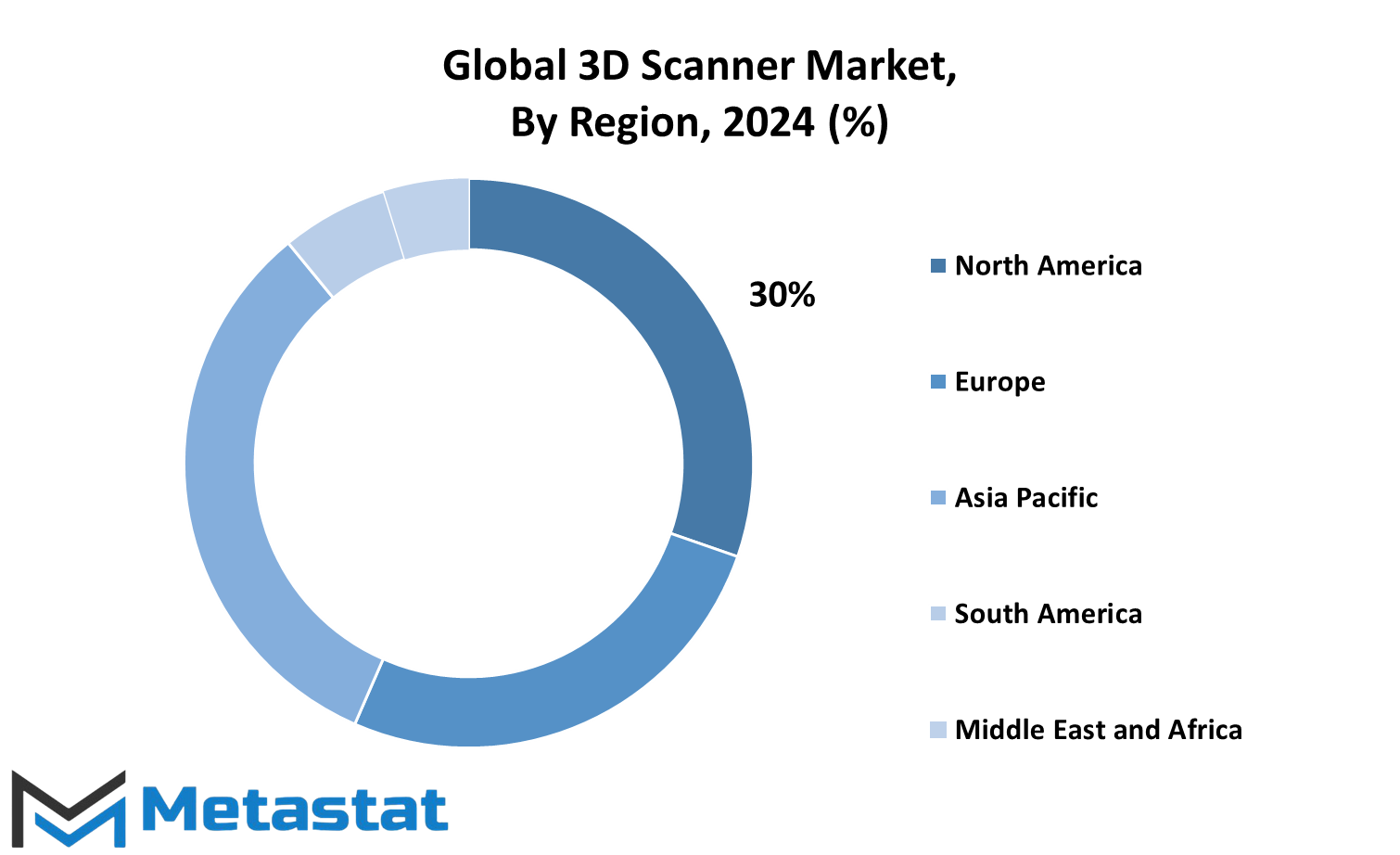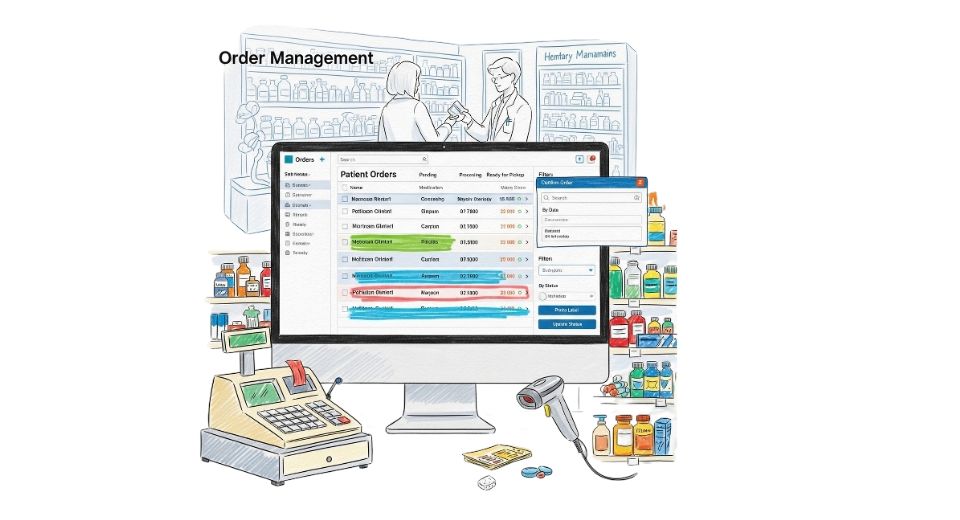MARKET OVERVIEW
The Global 3D Scanner industry and market is a dynamic sector characterized by the advanced technology driving accurate three-dimensional data acquisition on all applications. It involves devices and software solutions in the scanning of objects to capture their shape and details in digital formats. The industry increasingly contributes significantly in automotive, aerospace, healthcare, construction, and entertainment industries, serving as a backbone for innovation and operational efficiency.
Core competency of the Global 3D Scanner market will be the offering of highly precise measurements, to reverse engineer items, inspect qualities, and in product design, to name some. The techniques utilized include laser scanning, structured light scanning, and photogrammetry. This equipment scans items and captures point clouds, allowing them to translate the data points into digital models for further work or replication. As industries continue to push for speed and accuracy, 3D scanning stands out as a technology that minimizes errors while optimizing workflows.
The Global 3D Scanner market is defined by its expanding applications across both traditional and emerging industries. For instance, the automotive sector leverages this technology for rapid prototyping and ensuring compliance with stringent quality standards. In healthcare, 3D scanners assist in creating precise prosthetics and surgical models, underscoring the technology’s life-changing impact. Similarly, the construction sector uses this technology for detailed building information modeling, enabling architects and engineers to plan with unparalleled precision.
What sets the Global 3D Scanner market apart is its continuous development in terms of functionality and accessibility. The use of artificial intelligence and machine learning is improving the scanning process through smarter data analysis and predictive modeling. Cloud connectivity and advanced software solutions allow users to store, share, and manipulate 3D models easily. As technology advances, devices are becoming more compact and user-friendly, which opens the doors for broader application across industries.
Geographical-wise, the Global 3D Scanner market represents scattered adoption rates across the different technological infrastructures and industrial needs. North America and Europe are ahead due to their prosperous industrial bases and keen interest in innovations. Asia-Pacific is yet emerging as an important player since there is rapid industrialization and other industries like manufacturing and healthcare are growing in there. This type of global diversification ensures a continuous flow of innovation and adaptation across markets.
The Global 3D Scanner market is likely to expand further going forward with the increasing acceptance of digitization and automation through the adoption of principles of Industry 4.0, which will amplify the demand for 3D scanning technologies. 3D scanning will facilitate more streamlined and connected manufacturing processes. Other applications beyond virtual, augmented reality, and the metaverse will have the scope to open new avenues for this market.
In a nutshell, the Global 3D Scanner market is an important aspect of modern industrial and technological landscapes. The market will significantly influence the future of many sectors because of its potential to increase precision and simplify procedures. Its flexibility and constant advancement in technology make it relevant and continue to grow in the years ahead, and thus, this market is not optional in the current digital and industrial transformation.
Global 3D Scanner market is estimated to reach $2,199.73 Million by 2031; growing at a CAGR of 6.9% from 2024 to 2031.

GROWTH FACTORS
Its increasing usage by all the industries of the world has generated importance to the global 3D Scanner market, with the growth rate of which relies on the enhancements in the technology and higher level of usage of the scanner in capturing dimensions as a three-dimensional model with applications in many business enterprises, one among them is in the area of healthcare. As these places become more proficient and exact within their lines, the necessity in the business sphere for scanning into three-dimensional pieces will rise exponentially.
One of the most prominent growth factors in the Global 3D Scanner market is increasing the need for quality inspection and analysis. For example, the automotive and aerospace industries continually seek ways of improving the quality of the product and minimize the waste level. The fact that 3D scanners give correct data makes them occupy very essential positions in those fields. Lastly, the health sector now incorporates 3D scanners much into prosthetics and diagnostics applications. This shows the impact of 3D scanners For improving patient care. All this shows why such companies are interested in investing in this technology.
The other significant driver is the integration of 3D scanners with advanced technologies like AI and automation. The combination offers better data analysis, which allows companies to produce better results within a relatively shorter period. The trend of using 3D scanners in the construction sector will also lead to an increase in the Global 3D Scanner market.
Despite the factors mentioned, the market’s growth might face hindrances through the following significant challenges. One, the high initial cost for devices makes it out of reach to most small and medium-sized businesses. In addition, operating and processing data in the sophisticated scanners require professional people, which puts limitations on several industries. For the market's growth to be sustainable, such challenges need to be addressed.
Despite these limitations, exciting opportunities lie ahead. The trend of customization and personalized solutions in various sectors will open new avenues for 3D scanners. For instance, in the health sector, customized medical devices and implants may be more accessible through this technology. Similarly, with industries focusing on sustainability, 3D scanning can help in resource optimization and waste reduction.
MARKET SEGMENTATION
By Type
Laser scanners are being used as the tool for accurate and precise data acquisition. These tools send laser beams scanning objects, giving detailed 3D models; these models can be extremely vital in the following applications: reverse engineering, quality control, prototyping, etc. Because these devices can efficiently perform in all environmental conditions, the industries using such devices would require less effort for improving the overall efficiency of work.
Structured light scanners, on the other hand, project patterns of light onto objects and measure deformations to create accurate 3D representations. They are especially effective in capturing fine details, making them ideal for applications such as dental imaging, art restoration, and even facial recognition. Their non-contact nature adds a layer of versatility, allowing scanning delicate or sensitive items without causing damage.
The employment of cameras and light makes optical scanners a contributor to the further advancement of the global 3D scanner market. They can capture complex geometries and have extensive applications in areas such as automotive design, medical imaging, and aerospace engineering. Optical scanners can provide real-time feedback that is useful in dynamic and precision applications.
In the coming years, the global market for 3D scanners is going to grow to great heights. Companies are adopting such technologies to produce their products more quickly and in a better quality standard. With artificial intelligence and machine learning being introduced, the capabilities of 3D scanners are likely to be raised up to perform even better with regard to the data analysis capacity and adaptation towards individual needs. Also, the pressure towards sustainability is more likely to ensure greater usage of 3D scanners in minimizing material waste and maximizing resource utilization.
The use of 3D scanners is still a developing field for businesses and researchers. With further advancements in technology and a continuously growing number of applications, the global 3D scanner market will play a transformative role in shaping the future of many industries.
By Product Type
The Global 3D Scanner Market is gradually carving the future of industries with its products that are technologically advanced. It has consequently gained significant attention owing to its capabilities to capture the precise dimension and minute features of an object within fast time and without invasive attempts. It is widely used across numerous industries, including health care, automotive, construction, and manufacturing, and is one of the reasons for its increasing global stature. Through market breakdown into tripod-mounted, fixed, portable, and desktop types of scanners, it becomes very evident what various applications can be found here and their effect.
Tripod-mounted 3D scanners have great stability in the scanning environment, enabling scans over large areas at high resolution. This particular scanner type finds extensive application in architecture, heritage preservation, and industrial design for high accuracy and reliability. As industries move towards automation and precision in their processes, this kind of scanner will be of extreme importance in fulfilling such demands. Similarly, fixed 3D scanners meet the requirements of environments that require consistent and repeatable measurements. These scanners are often used in quality control and manufacturing workflows, ensuring product standards are maintained with minimal errors.
Portable 3D scanners, on the other hand, have revolutionized how professionals work because they offer convenience and flexibility. It has become easy to carry these devices to any location, which makes them very popular in the health sector for medical imaging or the creation of prosthetics. They are also of great value in field inspections and reverse engineering work, where the data acquired is accurate without having to be limited to a specific environment. This shift in preference towards portability reflects the move towards efficiency and adaptability in professional practices.
Meanwhile, desktop 3D scanners are for small-scale applications that emphasize compactness and ease of operation. Such machines are mainly used by small businesses, educational institutions, and designers to make prototypes, analyze objects or use them in teaching students about the emergence of technology. The affordability of this type, in comparison with the others, has been so appealing that it provided a gate to innovation, even at the level of an individual.
Further into the future, a Global 3D Scanner will be able to witness innovations towards further improvement with respect to speed, precision, and comfort. With most industries embracing it, the more it is set to impact not only the field of design but also the scope of production, research, etc. Thus, this growth cycle ensures that it remains an imperative tool in contemporary workflows for developing solutions for the global economy.
By Technology
The most important factors contributing to the growth of the Global 3D Scanner market are the technologies that it encompasses. For example, laser triangulation is one of the most popular methods. A beam of laser on the surface of a product is projected onto that surface; the light is reflected from the surface, and is captured by a camera with utmost precision. For reverse engineering, as well as quality control purposes, it makes for the best product. Similarly, with Pattern Fringe Triangulation technology, where the structured light patterns are used to scan objects, speed and catching many tiny details are becoming popular. It is helpful in cultural heritage preservation and medical imaging, which involves many high-resolution data-intensive applications.
Laser Pulse-Based is often termed as time-of-flight technology. It measures the time taken by a laser beam that bounces back after hitting an object. This method is useful for the scanning of huge environments such as building sites or a whole room and is, therefore, very precious in construction and architecture. In contrast, Laser Phase-Shift Based scanning advances this idea by incorporating phase-shift measurements to achieve finer accuracy. The technology is widely sought after where fine detail and precision are required for applications such as aerospace and automotive design.
As industries advance further, the prospects of the Global 3D Scanner market will only increase. More and more companies now rely on such technologies for optimizing their business and product development operations. Hence, fast, reliable, and accurate scanning solutions will be sought. Artificial intelligence and machine learning might take it one step ahead in terms of better analysis and automation. The advancement in portability and affordability will make the devices accessible to a wider audience, opening new opportunities across various sectors.
The Global 3D Scanner market is expected to grow remarkably driven by its technological diversity and the ability to meet the needs of modern industries. With continued innovation and adoption, this market will play a very important role in shaping the future of technology and industry.
By Application
The Global 3D Scanner market is expanding steadily. Improvements in technology along with a greater number of applications are creating significant growth momentum in the global market. More industries are getting modernized and 3D scanning solutions have garnered immense demand for themselves in these industries. Such devices capture precise, detailed data, adding a lot of value to industries in various ways. From manufacturing to healthcare, the scope of 3D scanners is vast, and they are one of the tools that businesses would find indispensable if they are to innovate and achieve efficiency.
Reverse engineering is one of the main applications of 3D scanners. This process helps companies recreate existing objects or parts by scanning them to produce digital models. Such models are essential for design optimization, creating replacement parts, or even improving products for better performance. Reverse engineering helps address design flaws and streamline production processes in industries such as automotive and aerospace. This capability not only enhances efficiency but also opens up opportunities for customized solutions.
Another significant use is in quality control and inspection. Ensuring precision and adherence to specifications is a critical aspect of production, and 3D scanners excel in this area. Detailed data of manufactured parts can be captured by companies for comparison against the original designs in order to detect any deviations. This is highly important in those industries where accuracy is of the essence, like healthcare and heavy machinery manufacturing. The earlier detection of defects saves time and reduces waste, hence saving cost for businesses.
Virtual simulation is another promising application of 3D scanners. The entertainment and education sectors have just begun to utilize 3D scanning as a means to deliver highly immersive experiences. Realistic environments and objects can be created in digital platforms for the purposes of training simulations, gaming, and virtual reality. As demand for virtual solutions continues to rise, the development of these technologies will increasingly require the use of 3D scanners.
The flexibility of 3D scanners ensures their relevance to other applications also. They use it in areas such as architectural modeling, archiving artifacts during archaeological studies, and even within the arts where digital replicas of a work can be created. Versatility with precision in technology is something new that continues inspiring, making the component critical in future innovation.
In the future, the Global 3D Scanner market will have the power to change industries. Advancements will be ongoing, and it will get easier and more accessible to transform the way we design, manufacture, and interact with our surroundings.
|
Forecast Period |
2024-2031 |
|
Market Size in 2024 |
$1,378.33 million |
|
Market Size by 2031 |
$2,199.73 Million |
|
Growth Rate from 2024 to 2031 |
6.9% |
|
Base Year |
2022 |
|
Regions Covered |
North America, Europe, Asia-Pacific Green, South America, Middle East & Africa |
REGIONAL ANALYSIS
The 3D scanner global market has been growing, with technology's rapid advancements further changing the scope of industries. This market segment has become part of manufacturing, healthcare, the automotive industry, and construction and is highly reliant on its growth for its development. Its exact and efficient means of completing operations such as quality checking, reverse engineering, and fast prototyping allow it to take its rightful position in these different sectors.
The regional dynamics in this market exhibit the kinds of opportunities and difficulties the world may witness in many locations. One of the strong players in the global 3D scanner market is North America. The USA leads this particular region due to the wide adaptability of advance technology in diverse industries. Another significant contributor here is Canada, and Mexico through the increasing requirements in healthcare, automotive, among others. Its position in the market is supplemented by the dominating presence of key 3D scanner manufacturers already established in North America. Countries such as Germany, the UK, France, and Italy have been leaders in the use of 3D scanner technology in Europe.
There is an existing industrial base with growing investment in research and development in these nations. There has been high adoption of 3D scanners for architectural restoration and automotive production. Other regions of Europe are also slowly increasing in terms of demand because of the advancement of high-performance tools for industrial applications in fields such as aerospace and consumer electronics. The Asia-Pacific region has become an up-and-coming region for the global 3D scanner market. Countries such as China, India, Japan, and South Korea are industrializing rapidly and thus are developing a growing requirement for new technological solutions like 3D scanners.
China, with its considerable manufacturing sector and India, in which the stress on digital transformation is growing is also part of this trend. Japan and South Korea are, in turn using advanced technologies in order to upscale their production base, thus encouraging market growth. In South America, Brazil and Argentina are found to be adopting 3D scanner technology to a greater extent. Although this market is lesser in size than North America or Europe, a growing demand has been noticed there in construction as well as in industrial applications.
The Middle East and Africa market offers a lot of opportunities to the global 3D scanner market. Investment in infrastructure in Saudi Arabia and the UAE by these countries drives the demand for scanning technologies. There is also much growth in South Africa and Egypt, mainly on account of developing healthcare and construction sectors. The technology advancement will bring wide adoption of 3D scanners across regions. Each region will have its needs and economic factors to drive this advancement.

COMPETITIVE PLAYERS
The Global 3D Scanner market is expected to pick up pace in the coming years as the pace of technological advances and growing requirements for precise measurement solutions are enhanced. This type of 3D scanner takes highly detailed images of objects and has found applications in many sectors such as healthcare, automotive, aerospace, construction, and manufacturing. The ability of these scanners to generate correct data in short periods has seen their application in areas where precision and effectiveness are most required.
One of the major drivers in the growth of the 3D scanner industry is that these technologies are increasingly being accepted in industrial applications. The use of 3D scanners by industries for quality control, reverse engineering, and product development is recognized. These scanners provide improved accuracy, allowing companies to optimize the process and make fewer errors while increasing productivity as a whole. Further, the integration of artificial intelligence and machine learning with 3D scanning technologies is expected to further enhance their capabilities, making them smarter and more intuitive to use.
The competitive landscape of the Global 3D Scanner market features several key players striving to innovate and expand their market share. FARO Technologies, Hexagon AB, and Trimble Inc. are innovative companies that launch new, better solutions to continue meeting the challenges of the emerging market. Besides these, several other companies also invest in researching and developing their performance and versatility-increasing products like Nikon Metrology, 3D Systems Corporation, and Artec 3D. Collaboration between industry leaders and partnerships with academic institutions are also paving the way for groundbreaking developments in this field.
Niche markets are being addressed by smaller but equally dynamic players in the form of Kreon Technologies, Thor3D, and Capture 3D, Inc., each with special products tailored for particular industries. Other companies such as Leica Geosystems and Riegl Laser Measurement Systems GmbH emphasize the scanning solution, which tends to be the size of bigger projects, infrastructure development, or urban planning.
The Global 3D Scanner market is expected to expand further as businesses and consumers alike continue to appreciate the value these devices bring. Increasing affordability of 3D scanning technologies, coupled with their growing integration into everyday applications, will likely lead to widespread adoption. Therefore, with ongoing innovation and the commitment of competitive players to meeting emerging demands, the future for 3D scanner markets is rather promising, presenting solutions that are going to mold industries around the world.
3D Scanner Market Key Segments:
By Type
- Laser Scanner
- Structured Light Scanner
- Optical Scanner
By Product Type
- Tripod Mounted
- Fixed
- Portable
- Desktop
By Technology
- Laser Triangulation
- Pattern Fringe Triangulation
- Laser Pulse Based
- Laser Phase-shift Based
By Application
- Reverse Engineering
- Quality Control and Inspection
- Virtual Simulation
- Other Applications
Key Global 3D Scanner Industry Players
- FARO Technologies
- Hexagon AB
- Trimble Inc.
- Nikon Metrology
- 3D Systems Corporation
- Artec 3D
- Micro-Epsilon
- Creaform
- Topcon Corporation
- RangeVision
- Carl Zeiss Optotechnik GmbH
- Zoller+Fröhlich
- Capture 3D, Inc.
- Kreon Technologies
- ShapeGrabber
WHAT REPORT PROVIDES
- Full in-depth analysis of the parent Industry
- Important changes in market and its dynamics
- Segmentation details of the market
- Former, on-going, and projected market analysis in terms of volume and value
- Assessment of niche industry developments
- Market share analysis
- Key strategies of major players
- Emerging segments and regional growth potential








 US: +1 3023308252
US: +1 3023308252






